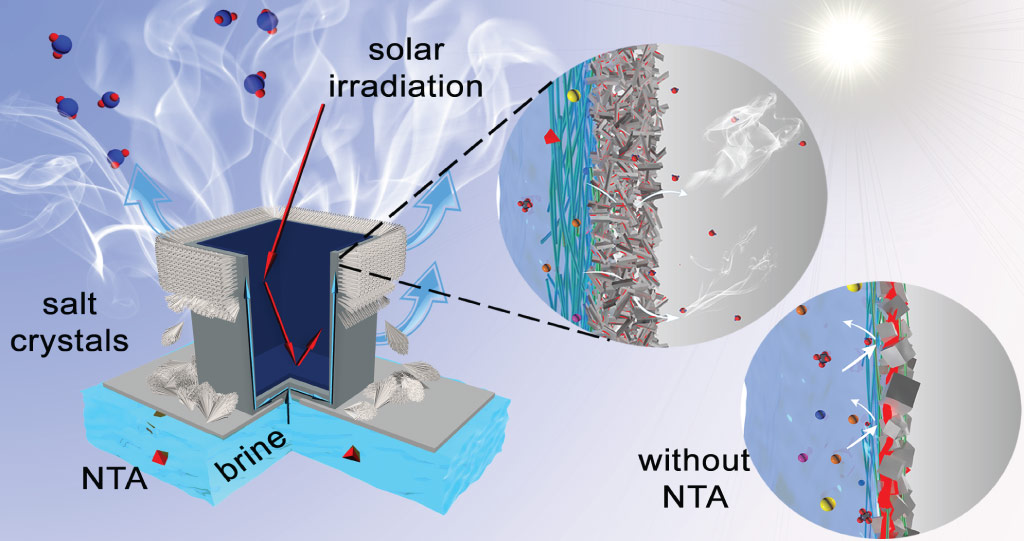Environmental Science and Engineering
A salt solution for desalinating brine
Solar-powered brine crystallization could alleviate the environmental impacts of seawater desalination.

Treating waste brine using a self-cleaning crystallizer that runs on solar power could be an eco-friendly and efficient way to make seawater desalination more sustainable.
In desert regions, seawater desalination provides essential freshwater for drinking and agriculture. A major problem is that the process generates vast quantities of concentrated brine that is often released into nearby lakes and rivers or back into the sea, harming vegetation and marine life. “With tightening environmental regulations and increasing public awareness, there is pressure to treat brine with zero liquid discharge,” says Chenlin Zhang, a Ph.D. student in KAUST. This means extracting every last drop of water while leaving behind solid mineral crystals that can be salvaged for other uses.
Crystallization currently requires either expensive corrosion-resistant containers and large amounts of energy to boil the brine or large areas of land as dedicated evaporation ponds. Solar crystallizers that use photothermal materials to convert sunlight into heat are gaining popularity but have limited performance because they accumulate salt crystals, which reduce light absorption at the surface.
To tackle this, a team led by Peng Wang built a three-dimensional crystallizer that separates the photothermal material from the brine using highly conductive aluminum. Sunlight enters the open top of a square column and a photothermal coating on the inside wall transfers heat through an aluminum sheet to the outside walls. A porous membrane wrapped around the outside absorbs brine from a reservoir below and spreads it across the surface. The heat evaporates the water and salt crystals build up on the outside, leaving the inner wall clean.

The three-dimensional crystallizer uses solar radiation as a heat source to evaporate the water. Useful minerals can then be recovered from the remaining accumulated salt crystals. (NTA: nitrilotriacetic acid).
© 2021 Nature; Zhang et al.
“Accumulated salt can be easily scraped off by hand or left to build up enough to eventually fall under its own weight,” explains Zhang. “Such self-cleaning could be very useful in industrial-scale systems.”
Their device performed well on experimental salt solutions, but when tested on water from the Red Sea, evaporation rates slowed almost to zero and magnesium crystals clogged up the pores.
Wang’s team resolved this by adding a small amount of nitrilotriacetic acid, a cheap and biodegradable crystallization inhibitor, to the untreated brine. “Our strategy could solve the long-standing issue of salt-scaling in conventional crystallizers and is a promising way to treat brine with zero liquid discharge,” says Wang.
When powered by artificial sunlight, their crystallizer treated Red Sea brine continuously for 288 hours, evaporating water at an hourly rate of 2.42 kilograms per square meter of surface. When powered by real sunlight on the rooftop of a residential building at KAUST, it evaporated 48 kilograms of water per day per square meter of surface, despite the hours of darkness.
Wang’s team is working on improvements to make their solar-powered crystallizer commercially scalable. “We will also investigate the recovery of useful minerals, such as magnesium and potassium, from the solid salts and reveal the true value of waste brine,” he adds.
References
- Zhang, C., Shi, Y., Shi, L., Li, H., Li, R., Hong, S., Zhuo, S., Zhang, T. & Wang, P. Designing a next generation solar crystallizer for real seawater brine treatment with zero liquid discharge. Nature Communications 12, 998 (2021).| article
You might also like

Environmental Science and Engineering
Bacteria reveal hidden powers of electricity transfer

Environmental Science and Engineering
Wastewater surveillance tracks spread of antibiotic resistance

Bioscience
Super fungi survive extreme Mars-like environments

Environmental Science and Engineering
Rethinking food systems to restore degraded lands

Environmental Science and Engineering
Combat climate change by eliminating easy targets

Environmental Science and Engineering
Wastewater treatment to fight the spread of antibiotic resistance

Bioscience
Digging into the world of plant-growth-promoting microbes

Bioscience




